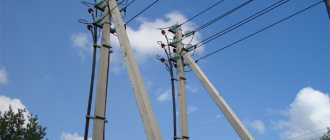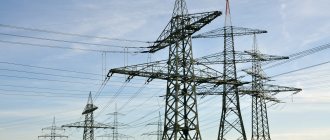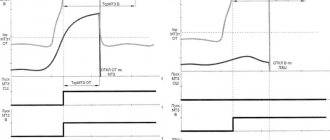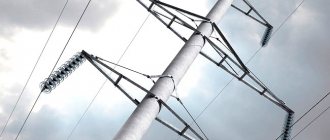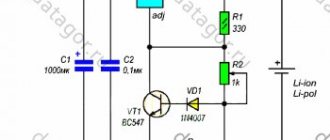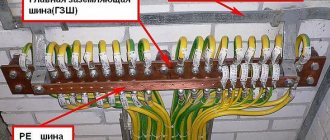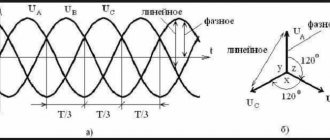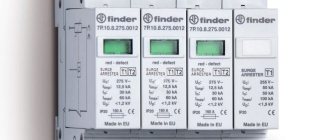Causes and danger of power surges
When there is a voltage drop in electrical networks, its amplitude changes for a short period of time. After this, it is quickly restored with parameters close to the initial level.
Such an electric current impulse lasts literally for several milliseconds, and its occurrence is due to the following reasons:
- Lightning discharges. They cause voltage surges of up to several kilovolts, which no device can withstand. Such fluctuations often cause network outages and fires.
- Overvoltage caused by switching processes when high power consumers are connected or disconnected.
- The phenomenon of electrostatic induction when connecting electric welding, commutator motors and other similar equipment.
The danger of consequences from overvoltages is clearly reflected in the figure, where lightning and switching impulses differ significantly from the rated mains voltage. The insulating layer in most wires is designed to withstand significant differences and breakdowns usually do not occur. Often the pulse does not last long and the voltage, passing through the power supply and stabilizer, simply does not have time to rise to a critical level.
Sometimes the insulation layer of a 220 V network may not withstand the increasing voltage. As a result, a breakdown occurs, accompanied by the appearance of an electric arc. For the flow of electrons, a free path is formed in the form of microcracks, and gases filling the microscopic voids serve as a conductor. This process is accompanied by the release of a large amount of heat, under the influence of which the conductive channel expands even more. Due to the gradual increase in current, the operation of the automatic protective equipment is slightly delayed, and these few moments are enough to damage all the electrical wiring in a private house.
Particularly dangerous are high and low voltages that remain in this state for a long time. This mainly happens due to emergency situations that need to be eliminated in order for the current to return to normal. There are no other methods of normalization or any special devices that protect against this phenomenon.
Types of overvoltages
There are different types of overvoltages:
- Pulse ones can reach a significant value, but they act for a short moment in time. It is not uncommon for them to exceed 1000 V.
- Switching problems arise as a result of technological processes occurring at the supply substation. When switching, strong voltage pulses may occur. Typically, mitigation measures are taken in advance, but sometimes they affect the consumer's supply network.
- Emergencies occur as a result of emergency situations. One example is lightning striking electrical equipment at a power substation.
Also, emergency situations can arise due to the gradual accumulation of static electricity.
Types and principle of operation of protective devices
Protecting the electrical network from power surges can be done in different ways. The most common and effective are the following:
- Lightning protection systems.
- Surge Protectors.
- Overvoltage sensors used in conjunction with RCDs. In the event of a malfunction, they cause a current leakage, under the influence of which the protective device will operate.
- Overvoltage relay.
Similar functions are performed by uninterruptible power supplies, with the help of which computers are connected to the home network. These devices do not protect against overvoltage; they act like batteries, allowing you to shut down the computer normally and save the necessary information in the event of a sudden power outage. This device cannot stabilize the voltage.
Electrical impulses are generated by lightning. Protection from their negative impact is carried out by installing a lightning arrester used in conjunction with an SPD - a surge protection device. It is also known as surge protector. In addition, it is necessary to provide additional security against electronic flow with parameters that differ from the operating characteristics of a given network. For these purposes, special sensors used with RCDs and overvoltage protection relays are used. The purpose and principle of operation of these devices is not the same as that of a stabilizer.
The main function of both components is to stop the supply of electric current when the voltage drop exceeds the maximum value determined by the technical specifications of these devices. After the network parameters are normalized, the relay turns on independently and resumes the current supply.
How protection works
Overvoltage is a voltage in the network that is several times higher than the permissible values. This may cause an insulation breakdown. Typically, a sudden increase in voltage creates a surge in current. Therefore, the sensors that need to monitor the situation can respond to any of these characteristics.
Surge protection is based on the fact that an excess of voltage and current is automatically detected, and then the power supply is disconnected from the area where the problem occurred. It is understood that the technician will check the situation in detail and then turn on the power again. There are automatic protection systems where reconnection occurs automatically.
Vertical metal rods are used to protect against lightning strikes. One end is in the ground, and the other is located above the support or building that needs to be protected. Horizontal lightning rods are used for power lines. They are metal rods located above the phase wires.
To protect buildings, metal mesh, roof covering or reinforced concrete load-bearing structures can also be used. If this is not possible, use a metal rod in the same way as described above. As for liquid tanks, they are protected from overvoltage by grounding.
It should be noted that the overvoltage can be very small. In this case, it is advantageous to use a stabilizer, which provides stable power to electrical equipment. It is advantageous to use for technical devices that are highly sensitive to supply voltage fluctuations.
Surge suppressors
When considering issues of network overvoltage protection, it should be noted that this function should primarily be performed by organizations responsible for power supply. They are the ones who install the necessary protective devices on power lines. However, as practice shows, this is not always done, and consumers themselves are forced to solve the problem of protecting their home from overvoltage.
Protection against overvoltage in the network at substations and overhead power lines is carried out using surge arresters - nonlinear surge suppressors. The main component of these devices is a varistor, which has nonlinear characteristics. Its nonlinearity consists in the changing resistance of the element in accordance with the magnitude of the applied voltage.
When the electrical network is operating in normal mode, and the voltage is at its nominal value, the voltage limiter at this time has a large resistance that prevents the passage of current. If, during a lightning strike, an overvoltage pulse occurs, a sharp decrease in the resistance of the varistor occurs to a minimum value and all the energy of the pulse goes into the ground loop connected to the arrester. This ensures a safe voltage level and ensures that all equipment is reliably protected.
The nature of various types of overvoltages
To deal with overvoltage, you need to understand in what situations and for what reasons it can occur. The most common cases are discussed below.
Zero phase break
In a 230 V socket, one wire is phase and the other is neutral. The latter is laid to the supply substation, and there it is grounded. In terms of its functions, the neutral wire is similar to grounding, but performs slightly different functions. If three-phase voltage enters the house, the neutral wire balances it. It operates in such a way that the potential difference between it and any phase wire is 220 V. If a grounding wire is installed in the socket instead, its use can lead to the voltage at the socket in the apartment going beyond the established limits.
During prolonged use or as a result of an emergency, the neutral wire may be damaged. Because of this, the voltage at the outlet will be determined by random circumstances. In particular, it can reach 380 V, which is dangerous for household electrical appliances. If protective measures are taken correctly, then there will be no problems.
Transformer malfunction at the supply substation
Electricity in a house or apartment comes from electricity suppliers. If their equipment is faulty, then there will be a non-standard voltage on the phase or neutral wire in the socket. This situation does not depend on the electricity consumer and can lead to problems with electrical equipment.
Impact of thunderstorm
Every modern house has a lightning rod. It is usually triggered when struck by lightning, but sometimes emergency situations may occur.
During a thunderstorm, a strong negative charge accumulates in the atmosphere. It forms a kind of capacitor with the surface of the earth. When the potential difference reaches a critical value, ionization of the air occurs and a discharge in the form of lightning is formed.
When energy accumulates in the wires of power lines, a positive charge accumulates, which is attracted by the negative charge. After a lightning strike, a discharge occurs, as a result of which positive charges begin to spread throughout the network. Consequently, two overvoltage waves occur, which propagate in two directions.
As a result, overvoltage may occur due to a lightning strike or due to charge redistribution, the mechanism of which is described above. In this case, there is a danger not only for the equipment used, but also for human life.
As a result of filling the tanks
The presence of liquid in the tank in some cases leads to the formation of static electricity. The immediate cause of this is the presence of friction created by the flowing liquid. If there is dirt or various impurities in it, then this effect is enhanced.
Installation errors
Sometimes during installation work the wires may be connected incorrectly. For example, this situation occurs when the neutral and phase wires are mixed up. The presence of worn-out and poor-quality wiring can also lead to an emergency.
Other types of protective devices
There are other options for protecting against network surges. They are widely used in everyday life and are considered one of the most effective means.
Network filters
They are distinguished by their simple design and affordable cost. Despite its low power, this device is quite capable of protecting equipment during surges reaching 380 volts and even 450 volts. The filter cannot withstand higher pulses. It simply burns out, keeping expensive electronics intact.
This surge protection device is equipped with a varistor, which plays a key role in providing protection. It is this that burns out at pulses above 450 V. In addition, the filter reliably protects against high-frequency interference that occurs during welding or electric motors. Another component is a fuse that trips during short circuits.
Types of protective equipment
Due to the wide variety of causes of overvoltage and its characteristics, it is not possible to use only one type of protection for electrical installations in all cases. Therefore, there are various devices. They are used depending on which emergency situations are more likely.
Lightning rods
The principle of their operation is based on the fact that the charge, flowing to the ground, chooses a path along which the resistance will be minimal. Such devices are one or more metal rods, each of which is dug into the ground at one end and extends onto the roof at the other. The top may include a horizontal metal mesh or roof covering of such material.
Traffic jams or automatic machines
In apartments, plugs are often installed on electrical panels to protect against power surges. They use a fuse as the main element - a piece of wire that will melt if the current exceeds the set level. Immediately after this, the supply of electricity through the plug will stop.
The advantages of plugs are ease and reliability of use.
The disadvantages are:
- Slow reaction. The fuse will not respond immediately, so the high current may harm electrical appliances or people.
- The fuse used is disposable. After operation, you need to insert a new one. Therefore, it is always necessary to have a spare one.
For a long time, the use of traffic jams was widespread, but over time they began to be replaced by automatic machines. They are screwed in the same way as plugs, but are not one-time devices. When the current in the network exceeds, they automatically turn off, after which the owner can put them back into operation by pressing the appropriate button.
Automatic protective devices help in most cases, but cannot save you, for example, in the event of a lightning strike. Therefore, it is more profitable to use them in conjunction with other devices.
Network filters
Externally they look like extension cords. They have built-in varistors that provide protection against voltage surges. When using this equipment, it must be remembered that effective protection is provided only if the surge protector is grounded.
A varistor provides a connection between the neutral, phase and ground wires. If the voltage in the electrical network exceeds a predetermined value, a connection to grounding will occur and a dangerous charge will end up going into the ground.
Surge filters are most often used for low-power equipment. They are designed to protect against surges up to 400–500 V.
Protection relay
Such devices automatically turn off the electricity when the set voltage value is exceeded. In some models, restarting occurs automatically, in others it must be done by a person.
The relay is installed immediately after the input circuit breakers. They have such advantages as:
- High response speed allows you to save equipment and people from the destructive effects of overvoltage. In an emergency, the power goes out within just a few seconds.
- The device is capable of performing its functions at currents up to 60 A.
- Simple installation can be done even by a person who is doing it for the first time.
- Some models have a display where you can see the current value in real time.
The device is able to effectively respond to a break in the neutral wire and to significant voltage surges of other types.
Undervoltage and overvoltage release
The device constantly monitors the voltage value. As soon as it becomes too large or small, it automatically switches off.
The device is easy to install and highly efficient. It is a reliable means of protection against breakage of the neutral wire or phase imbalance in the supply network. The disadvantage of this device is the lack of an automatic switch-on function. This can cause problems in some situations. For example, turning off the refrigerator while no one is home can lead to food spoilage. The release is not effective when high voltage pulses occur.
Stabilizers
The stabilizer is connected to an outlet, and the electrical appliance is connected to it. It smoothes out power surges, providing high-quality power to the equipment.
Stabilizers are highly reliable and have a long service life, but may not cope with a strong voltage surge. The stabilizer operates automatically and responds quickly when the need arises. The main disadvantage of such protective equipment is the relatively high price.
SPD devices
They are designed to protect against surge voltages in the network. Effective for almost any impulse, including those caused by a lightning strike.
The principle of operation of protective devices is based on sensitivity to a sharp increase in current strength. They disconnect from the network almost instantly, so electrical appliances do not have time to feel the influence of the impulses. The surge protection device prevents overloads of any complexity. When using it, it is possible to change modes and set a delay. When a failure occurs, the system may not start immediately, but after some time.
Network overvoltage protection is an important measure that allows not only to extend the service life of electrical equipment, but also to ensure its safe operation during voltage surges.
Lightning protection - external protection
External protection includes a lightning rod, which, as a rule, is installed at the highest point of the house; the lightning rod is connected to a conductor that discharges the discharge to the ground. There was a time when a lightning rod was connected to the grounding of the house circuit. As it turned out, it is better to use independent grounding to remove a lightning discharge. The characteristics of the lightning rod grounding conductor must be the same as that of the house grounding loop. It must also be deepened into the ground using pins by at least 3 meters.
lightning discharge to the ground
For private houses, a lightning rod is often installed on the roof of the house. Lightning rods are:
a) a cable lightning rod, fixed to the racks of the end parts of the house and stretched along the ridge, or a high metal lightning rod is used, which is installed vertically and secured with guy wires or a special fastening designed to withstand wind loads.
home protection from lightning - lightning rods
b) another option, when a metal mesh of rods is laid on the roof, welded with a cell pitch of 2–5 m, with a cross-section of rods of 8–10 mm².
Lightning protection - mesh
c) the third version of the lightning rod is used if the roof is metal, then there is no need to use the two previous designs. You only need to ground the roof using a conductor and lead it into the ground.
It is better to use a steel conductor through which the thunderstorm energy of lightning will flow to the ground electrode, with a cross-section of at least 16 mm², or a copper wire with a cross-section of at least 10 mm².
conductor for lightning rod
This is exactly the case when you can’t spoil the porridge with oil: the thicker the wire, the safer it is. The metal conductor is usually connected to the lightning rod by welding or by bolting in the case of a copper conductor. The conductor is lowered along the outer wall of the house, to which it is attached using special clamps on non-flammable materials. It is advisable to lay the lightning rod conductor on a blank wall, away from the front door and windows. The lightning rod conductor should not pass through metal elements (metal stair railings, water and drain pipes) and at a distance of these structures no closer than 30 cm.
Surge Protectors
Stabilizers provide reliable network overvoltage protection. If the voltage goes beyond the maximum permissible range, the stabilizer disconnects the connected group from the network. When the voltage returns to normal, the regulator turns on the power again. Modern stabilizers are equipped with displays that display the current voltage and show a graph of its surges.
There are various types of these devices on sale:
- relay;
- ferroresonant;
- electromechanical;
- triac.
There are various schemes for installing regulators. The best option is to install the device on each electrical appliance that needs to be protected. This scheme is good because for each consumer you can select a stabilizer suitable for accuracy and power. Of course, this option is also the most expensive, so most often one stabilizer is installed for a group or for the entire apartment. Its power is calculated by summing the power of all devices.
Possible damage due to lightning
The magnitude of lightning voltage is measured not even in thousands, but in tens and hundreds of thousands of volts. And even though the interference is literally lightning fast, even in a split second it manages to damage many internal elements of the equipment, rendering it inoperable. In refrigerators, the compressor usually burns out, in switching power supplies the primary voltage conversion circuit burns out, and so on.
But the trouble will not end there, because the failure of electronic equipment, and in this case it simply burns out, can lead to a real ignition and, as a result, a fire. And, unfortunately, only at this moment the owner of a private house realizes that he was wrong when, when installing a distribution panel, he decided to save on installing an SPD for a private house. And it’s also better not to save on servicing septic tanks; pumping out septic tanks in Solnechnogorsk using professional equipment at a reasonable price.
Voltage relay
Installing a relay is also a fairly effective way to secure your home network. In case of large voltage drops, the relay automatically turns off the consumer, and when stabilized, it turns on. Modern protective relays are available with microprocessors that allow finer tuning of the device.
Relays, like stabilizers, can be installed on individual devices, on groups and on the entire home network. When protecting a separate device, it is connected to a relay, and it is already connected to the power supply. When protecting the entire house or a group of devices, the relay is installed on the distribution panel.
Principle of operation
Overvoltage elimination is performed in two main modes:
- Unbalanced or common-mode. Phase-to-ground and neutral-to-ground circuits are used, in which all excess energy is discharged to the ground.
- Symmetrical or differential. Here, phase-to-phase and phase-to-neutral options are used, where all the energy is redirected for removal through another active conductor.
How the SPD works depends entirely on the design and design of the equipment. The first option involves the use of valve and spark gaps, which are especially effective in high voltage networks. When they are exposed to a lightning discharge, an air gap breaks through in the jumper under the influence of overvoltage. Since it connects the phase and the ground loop, the high pulse voltage will go into the ground.
If a spark gap is used instead of an air gap, then a resistor is used to dampen the pulse. SPDs with gas-filled arresters are recommended to be installed at facilities where there is an external lightning protection system or power supply is carried out using overhead lines.
The second option is a surge suppressor designed around a varistor connected in parallel with the equipment being protected. In normal operating mode, a very small current, close to zero, passes through the varistor. However, when an overvoltage occurs, its resistance drops sharply and the high current flows freely through the protective component, dissipating all the received energy. After this, the voltage decreases to the nominal value and the varistor again operates in non-conducting mode.
All devices are equipped with built-in thermal protection that prevents burnout at the end of their service life. Repeated operations lead to the loss of the useful qualities of the varistor, and it turns into a permanent current conductor. This state is determined by the indicator, and information about this is displayed on the display.
Specifications
When choosing a specific surge suppressor model, the following device parameters must be taken into account:
- Response time - characterizes the speed of opening of the semiconductor element of the limiter after the voltage rises.
- Operating voltage - determines the amount of electrical energy that the surge arrester can withstand without disruption for any period of time.
- The rated overvoltage is the operating value that the arrester is capable of withstanding for 10 seconds, and is also standardized together with the residual voltage that remains in the network.
- Leakage current - occurs as a result of the application of voltage to the surge suppressor and is determined by its ohmic resistance or resistor parameters. In good condition, this parameter is hundredths or thousandths of amperes flowing through the jacket and semiconductor from the source to the ground wire.
- Discharge current - a value generated during pulse surges, depending on the source of overvoltage, is divided into atmospheric, electromagnetic and switching pulses.
- Resistance to surge current – determines the ability to maintain the integrity of all structural elements in emergency mode.
Main devices of the protection system
One of the best ways to save the electrical network from voltage surges is to install a stabilizer that meets the technical specifications. These are not cheap devices, and they are not always used, since the voltage in the networks is already quite stable.
Voltage control relays also help eliminate network instability. In the event of a break in the neutral core and a short circuit in sagging cables, such a relay can turn on protective functions even faster than a stabilizer, it only takes 2-3 milliseconds.
Such relays are very compact - they require less space for installation than stabilizers, they are easily installed on a simple DIN rail, the cables are connected simply (unlike the installation of stabilizers, when they are forced to wedge themselves into the electrical network or install a special box for it). Stabilizers hum noticeably, so it is not advisable to install them in residential areas, but relays operate almost silently. In addition, devices that control electrical potential differences consume very little electricity. The price for such relays is several times lower than those for stabilizers.
The operating principle of the control relay is that with a constant supply of electric current, the device determines the potential difference and compares it with permissible values. If the indicators are normal, the keys remain open and current continues to flow through the network. If a powerful impulse passes, the keys are instantly closed and the power supply to consumers is cut off. Such a quick and unambiguous reaction helps to protect all connected household appliances.
Additional Information. Returning to normal mode occurs with a certain delay, controlled by a timer. This is necessary to ensure that large electrical appliances, such as refrigerators, air conditioners and others, turn on in compliance with the rules and technical settings.
The relay is connected via a phase cable, while the neutral cable is included in the internal circuit for power supply.
There are two methods: end-to-end connection (directly) or using a contractor device for communication. It is optimal to connect the relay mechanism before connecting the meter, which will also ensure its protection against overvoltage. However, if there is a seal on the metering device, you will have to install a relay behind it.
Pulse overvoltages in the electrical network of private houses occur due to thunderstorms with lightning or switching surges. For the safety of electrical wiring, special SPD devices are used. As a rule, these are nonlinear surge suppressors (OSN), stabilizers and potential monitoring relays. Of course, setting up such a system is an expensive undertaking, but its cost is much lower than that of expensive electrical household appliances.
Surge protection device: how to choose and install the module correctly
Imagine a picture when the accumulated energy of static electricity between clouds moving over long distances is discharged by a lightning strike on a building or the power line feeding it.
The average shape of the current pulse is shown below. It first increases steeply for about 10 milliseconds, and then, having reached its apogee, begins to decrease smoothly. Moreover, the decline to the middle of the maximum current value occurs after 350 ms and continues further until zero.
This lightning impulse creates an overvoltage in the network, which approximately follows the shape of the current, but may differ due to the operation of surge suppressors installed on overhead power lines.
The shape of such a pulse processed by spark gaps is shown a little to the right, and a conventional sine wave with a frequency of 50 hertz is below for comparison.
Power line surge suppressors operate by breaking through a calibrated air gap with an increased discharge pulse. In the normal state, its resistance prevents the flow of currents from a voltage of normal magnitude.
The limiters of high-voltage power lines are quite impressive in size.
On 0.4 kV overhead power lines their dimensions are significantly smaller. They are located on a support next to the insulators.
Overvoltage suppressors for overhead lines are capable of extinguishing very high lightning voltages only up to 6 kilovolts. Such a pulse has a modified voltage rise and fall shape with a characteristic of 8/20 μs. It goes to the input devices of your home.
Transmission line surge protection has greatly reduced and transformed it. But this is clearly not enough to ensure the safety of equipment and residents.
Household wiring 220/380 volts is produced with insulation capable of withstanding impulses of 1.5 ÷ 2.5 kV. Anything bigger breaks it. Therefore, it is necessary to use an additional surge protection device for a private home.
The range of such designs is extensive. They need to be able to select and install correctly.
SPDs for a 0.4 kV network are available for 2 possible emergency extinguishing modes:
- discharge current with a form of 10/350 μs, which did not change from the surge arrester of the overhead power line;
- overvoltage pulse with characteristic 8/20 μs.
Based on these factors, it is convenient when choosing an SPD to use the algorithm that I showed in the picture below.
However, one should imagine that there are practically no devices capable of one-time extinguishing a 6 kilovolt pulse to a value of 1.5 kV that is safe for household wiring.
This process occurs in three stages. Each of them uses its own class of SPD, although there are small exceptions to this rule.
Class 1 modules are capable of reducing an overvoltage impulse from 6 to 4 kV, which penetrates:
- after power line limiters;
- or induced by the lightning discharge current flowing down the lightning rod;
- or its impact on nearby buildings, trees, or soil.
Class 1 surge protectors are installed in the building's input panel inside a separate sealed fireproof cell. Neglecting this rule is dangerous.
During installation, the protected cables must be laid correctly. They should not intersect with the discharge of emergency currents to the ground circuit and incoming, unprotected highways.
The modules are protected from overcurrents by power fuses with fuse links.
Automatic switches are not suitable for these purposes. Their contacts cannot withstand the generated impulse overloads. They are welded, and the damage continues to develop.
The next class of SPD No. 2 reduces the overvoltage impulse from four to 2.5 kV. It is placed in the next distribution board in the hierarchy, for example, an apartment one. It complements the work of the previous module, but can also be used autonomously.
Class No. 3 surge protection devices can be made in modules installed on a DIN rail or in kits built into household appliances, extension cords, and surge protectors.
Manufacturers are concerned about the complexity of choosing the correct SPD design and offer a comprehensive solution to this issue with a general module called 1+2+3.
It is placed in a separate box. However, the price of such a development is not affordable for everyone.

